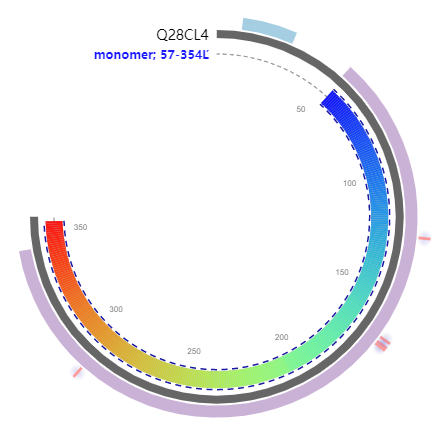Adenosine 3',5'-bisphosphate + H(2)O <=> adenosine 5'-phosphate + phosphate. adenosine 3',5'-bisphosphate + H2O = AMP + phosphate.
MAPMGIRLSPLGIGVFCLLGLGVLYHVYSGFLTGKFSAFLLGDRAEDPGPGEDTVDLREL
LAVSVRAAELGGLEVKKVRESNSLNEKAKGKTMEGADDKMTSGDVLSNKKMYHLIKNAFP
ALKVNTEEKVEADDEDAVSWDRNIPDDIKEQIKTKHVASESITMWIDPLDATQEYTENLV
NYVTTMVCVAVNGKPVIGVIHKPFTGFTAWAMLDGGSSIKKRNSYNEKTPTFIVSRSHSG
EVKEVTRQTFGNKTEIISAGGAGYKVLSLLDVTDDKQETADVYIHVTYIKKWDICAGNAI
LNALGGQMTTLKGEEIMYTGSELNKGGLLASIGMDHGVLVEKLSEKLQVNAKKPAK361

| PMID | Title & Author | Abstract | Year | |
| 0 | 32417395.0 | Genome-wide association study reveals candidate genes associated with body measurement traits in Chinese Wagyu beef cattleB An , J Xia , T Chang , X Wang , L Xu , L Zhang , X Gao , Y Chen , J Li , H Gao | We performed a genome-wide association study to identify candidate genes for body measurement traits in 463 Wagyu beef cattle typed with the Illumina Bovine HD 770K SNP array. At the genome-wide level, we detected 18, five and one SNPs associated with hip height, body height and body length respectively. In total, these SNPs are within or near 11 genes, six of which (PENK, XKR4, IMPAD1, PLAG1, CCND2 and SNTG1) have been reported previously and five of which (CSMD3, LAP3, SYN3, FAM19A5 and TIMP3) are novel candidate genes that we found to be associated with body measurement traits. Further exploration of these candidate genes will facilitate genetic improvement in Chinese Wagyu beef cattle. | 2019 |
| 1 | Chondrodysplasia and abnormal joint development associated with mutations in IMPAD1, encoding the Golgi-resident nucleotide phosphatase, gPAPP Lisenka E L M Vissers , Ekkehart Lausch | We used whole-exome sequencing to study three individuals with a distinct condition characterized by short stature, chondrodysplasia with brachydactyly, congenital joint dislocations, cleft palate, and facial dysmorphism. Affected individuals carried homozygous missense mutations in IMPAD1, the gene coding for gPAPP, a Golgi-resident nucleotide phosphatase that hydrolyzes phosphoadenosine phosphate (PAP), the byproduct of sulfotransferase reactions, to AMP. The mutations affected residues in or adjacent to the phosphatase active site and are predicted to impair enzyme activity. A fourth unrelated patient was subsequently found to be homozygous for a premature termination codon in IMPAD1. Impad1 inactivation in mice has previously been shown to produce chondrodysplasia with abnormal joint formation and impaired proteoglycan sulfation. The human chondrodysplasia associated with gPAPP deficiency joins a growing number of skeletoarticular conditions associated with defective synthesis of sulfated proteoglycans, highlighting the importance of proteoglycans in the development of skeletal elements and joints. | 2011 | |
| 2 | Identification of mitogen-activated protein kinase docking sites in enzymes that metabolize phosphatidylinositols and inositol phosphates. Marcos Sosa, Kevin Caldwell, Colin Buckley | Background: Reversible interactions between the components of cellular signaling pathways allow for the formation and dissociation of multimolecular complexes with spatial and temporal resolution and, thus, are an important means of integrating multiple signals into a coordinated cellular response. Several mechanisms that underlie these interactions have been identified, including the recognition of specific docking sites, termed a D-domain and FXFP motif, on proteins that bind mitogen-activated protein kinases (MAPKs). We recently found that phosphatidylinositol-specific phospholipase C-γ1 (PLC-γ1) directly binds to extracellular signal-regulated kinase 2 (ERK2), a MAPK, via a D-domain-dependent mechanism. In addition, we identified D-domain sequences in several other PLC isozymes. In the present studies we sought to determine whether MAPK docking sequences could be recognized in other enzymes that metabolize phosphatidylinositols (PIs), as well as in enzymes that metabolize inositol phosphates (IPs). Results: We found that several, but not all, of these enzymes contain identifiable D-domain sequences. Further, we found a high degree of conservation of these sequences and their location in human and mouse proteins; notable exceptions were PI 3-kinase C2-γ, PI 4-kinase type IIβ, and inositol polyphosphate 1- phosphatase. Conclusion: The results indicate that there may be extensive crosstalk between MAPK signaling and signaling pathways that are regulated by cellular levels of PIs or IPs. | 2008 |
Caldwell KK, Sosa M, Buckley CT.Identification of mitogen-activated protein kinase docking sites in enzymes that metabolize phosphatidylinositols and inositol phosphates.Cell Commun Signal 4:2 (2006).